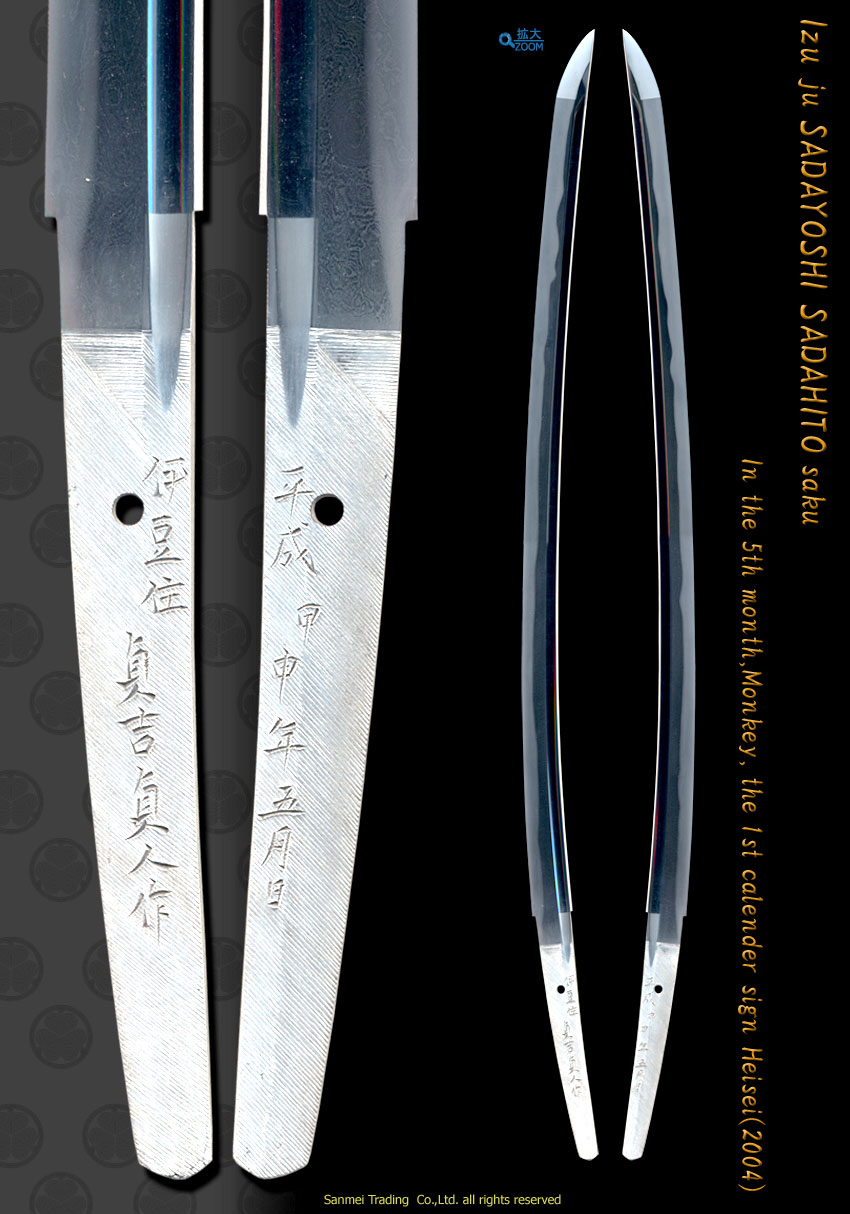In the 5th month, Monkey, the 1st calender sign Heisei (2004)
Length of cutting edge70.3cm Curvature1.9cm Width of base32.5mm Width of Yokote24.5mm Thickness of base7.0mm
Blade construction: Shinogi zukuri, Mitsu-mune. Wide in Mihaba, less volume
in Hiraniku leading to an extended large tip. There is chiselled away grooves
on both sides.(click HERE for higher resolution
image of the entire blade).
Forging(Hada): Clear Ayasugi-style hada ware. Hiraji is covered in abundant
Ji-nie glitter to generate darkish ranging swirl hard metal stream lines
so called Chikei activity. Dramatic and vivid Jihada - grand sight.
Temper(Hamon): Hamon forms Norare wavy in general, mixing in box-shape
gunome and small zigzag (ko-midare). Temper edge is covered with soft Nie
and Nioi granule and shows many activity of Nie such as Uchinoke, Kinsuji,
Inazuma and Sunagashi frequently that is harmonized with Chikei in Hiraji
surface. Upper the blade, wider the temper, thicker the Nie and deeper
the Nioi. Upper Monouchi area activates Nie activity of thick Nie-lines
such as Inazuma-thunder and Fish-hook shape which correlate with swirling
Chikei activity in Hiraji.
Tang(Nakago): Nakago is in UBU original. One peg hole. Kurijiri V-shape
round bottom shape and Katte-Sagari (Slanting left) with horizontal filemarks.The
signature in front starts with living place [Izu-ju] and the joint work
[SADAYOSHI SADAHITO-saku]. The reversed side is chiselled with the date
of year [In the 5th month, Monkey, the 1st calender sign Heisei]. Superb
Nakago workmanship.
Temper of tip(Boshi): Large Boshi is irregular Midarekomi with Ichimai
(whole tip tempered), Burl mokume Kinsuji activity in the tip.
This katana is a joint work by Enomoto Sadayoshi, the Mukansa swordsmith,
and his son Enomoto Sadahito. Enomoto Sadayoshi, real name is Enomoto Sadaichi,
was born in 41th year of Meiji (1909) in Tokushima prefecture, and studied
under Gassan Sadakatsu since the 3rd year of Showa (1928). He succeeded
Gassan style Ayasugi wavy hada then moved to Mishima city in Shizuoka prefecture
in the 18th year of Showa (1943). He went to win many prizes at the NBTHK
competition and enjoyed a Mukansa treatment in the 56th year of Showa (1981),
then officially became the top Mukansa swordsmith in the 8th year of Heisei
(1996). To achieve a Mukansa title, one have to win an assortment of the
eight top prizes, so it usually takes may years or decades under fierce
competition. Under Gassan Sadakatsu's pupils, he is known as an expert
of beautiful Ayasugi-style forging, next to the Natinal Treasure swordsmiths,
Gassan Sadakazu and Takahashi Sadatsugu.
The skin of this katana shows his typical example - a very clear and vivid
Ayasugi-hada and bears a signature of joint-work with his son Sadahito.
Enomoto Sadahito, was born in the 29th year of Showa (1954) and studied
under his father Sadayoshi. He is an active swordsmith and has won several
prizes at the NBTHK competitions.
This is the Sadayoshi's posthumous work that shows a strong influence of
Soshu-school and gives off close resemble to the ancient work of Go Yoshihiro,
completely flawless and plenty of Inazuma, Kinsuji and Sunagashi activities
throughout the temper and Ayasugi-style Chikei forging marks against abundant
Ji-ne glitter.
Silver habaki collar, preserved in a Shira-Saya plain wood mounting.

